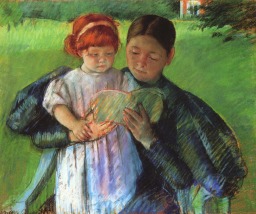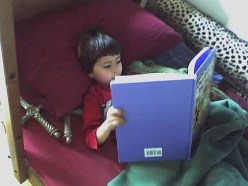What happens when a young child runs in and tells you about something exciting they have seen, heard or done?
… Narrations!
Charlotte Mason found that telling back is a fundamental skill in expressing what a child knows.
Here are the 2 skills – knows and tells. It is so simple. But I’m no expert and we are still refining these skills. For new homeschool moms and those with young children, may I share more?
How should we teach so they know?
Miss Mason suggests that we use living books, read to our children with clear, expressive voice, and tell our children that after we have read to them once only, they will tell us what they have heard.
How can this go wrong?
 The first thing most moms do is tell the child to listen, prompt them, discipline them, even nag them to focus and listen. Then they add sympathy and repeat what their children missed while they chased the cat under the table. And worse still, they correct them, add their thoughts and words and prompt them while they narrate. … I have been guilty of all these … any of you?
The first thing most moms do is tell the child to listen, prompt them, discipline them, even nag them to focus and listen. Then they add sympathy and repeat what their children missed while they chased the cat under the table. And worse still, they correct them, add their thoughts and words and prompt them while they narrate. … I have been guilty of all these … any of you?
Let’s start at the beginning:
Charlotte Mason said, “Our concern is to afford matter of sufficiently literary character, together with the certainty that no second or third opportunity for knowing a given lesson will be allowed.” (Vol. 6 pg. 171-172)

Use really engaging living books with rich vocabulary, great characters and wonderful thoughts and dialogue. Young children need stories with pictures! If the book or content is not suitable, I suggest you find another book. In my early homeschooling days, I followed the curriculum and squeezed my children to fit it. Now I prayerfully turn to other resources and lay aside the book that dragged us down.
Allow you children to listen without distraction, yet keep busy hands. Colouring in pictures on the topic, or cutting and folding a minibook for the notebook page all are helpful activities that reinforce the content. Play dough and felt-board pieces, knitting or embroidery are quiet too. I found that, although my children love to play Lego while I read aloud, moving the pieces make a dreadful racket!
Charlotte Mason said that, “complete and entire attention is a natural function which requires no effort and causes no fatigue … the concentration at which most teacher aim is an innate provision for education and is not the result of training or effort.” (Vol. 6 pg. 171-172)

Children often live up to our expectations. Tell them what you expect. Simply state that you will only read the chapter once and after that they will narrate to you. Then calmly read. They must give all their effort at attention. Charlotte Mason tells parents not to get in the way. We do not need to explain anything unless the child asks, “What does … mean?” It takes courage to allow the child to miss what he does not know for the present and express only what he does understand. (Note to self – do not explain!)
When you are finished, let your child start his narration. Often my youngest starts so that “she doesn’t forget her thoughts” while she waits as the others tell back. If the content is complicated, I ask the older children to tell back first so that in hearing their narrations, the younger child gets a quick “recap”.
A young child can draw their narration. I write out their oral narration under their picture. For longer narrations I type their oral narration on the computer, print it out and they can illustrate the page.
 In training a young child to write their own narrations, I start by writing their dictated narration in pencil and then they copy over my writing. Then, as they become less frustrated with the physical act of writing (which is really a chore), I write their dictated narration on a white board and they copy this written narration on their notebook page.
In training a young child to write their own narrations, I start by writing their dictated narration in pencil and then they copy over my writing. Then, as they become less frustrated with the physical act of writing (which is really a chore), I write their dictated narration on a white board and they copy this written narration on their notebook page.
 Eventually, by about 10 years, the child writes their own narrations. At first, I encourage them just to get their thoughts on the page. I ask them to read back their narration to me so that I can hear their words and don’t misinterpret any ‘strange’ spelling. My youngest child is at this stage now. If I pick out spelling and grammar mistakes, I will quench her joy of writing!
Eventually, by about 10 years, the child writes their own narrations. At first, I encourage them just to get their thoughts on the page. I ask them to read back their narration to me so that I can hear their words and don’t misinterpret any ‘strange’ spelling. My youngest child is at this stage now. If I pick out spelling and grammar mistakes, I will quench her joy of writing!
Gradually I encourage basic grammar like starting sentences with capital letters and ending with a full stop. I remind my children to keep their sentences short. If they fall into the habit of starting with “Then …. And then …” I may remind them to read through their own narrations and cross out the unnecessary words. Often I ask them what they think they need to change if they are unhappy with their narration.
I offer specific encouragement by telling them,”You gave lots of wonderful details,” or “What a good opening sentence/ conclusion,” or I really liked these descriptive words,” or “Boy, you really summed that up well!”
My middle schooler has entered into independent narration writing and puts her head down and writes till she has captured all her thoughts. She quickly fills a notebook page. She has gradually added more vivid vocabulary and details as she gained confidence. She loves notebook pages. If the history chapter I read aloud has several sub-sections, she requests time to write her narration before I continue to the next section.
 And my high school daughter writes all her own notes from the texts she reads on her own. She organizes all her own material, researches and creates rich and detailed assignments. Her computer skills and typing are vital to the content and presentation of her assignments.
And my high school daughter writes all her own notes from the texts she reads on her own. She organizes all her own material, researches and creates rich and detailed assignments. Her computer skills and typing are vital to the content and presentation of her assignments.
Narrations allow a child of any age to take hold and make their own whatever knowledge they engage with. Keep at it and raise the standard as your children grow up. Narrations really work!
This post was written for the upcoming Charlotte Mason Carnival. Why not join in and submit your own post?
Blessings,
Pingback: Letter 23 – Fears | Practical Pages
Pingback: Narration Notecards & Word Banks | Practical Pages
I am still struggling with narration. And I’m honestly not sure how much of it is me and how much of it is my son. But we read, and I ask for narration and ….. um…. I’m lucky if he can tell me one thing out of say a page of something. Whether it’s our history, our latest book (picture book) on Michelangelo, or whatever. If it’s our fiction read, he usually does very well. If it’s something like Michelangelo – which is admittingly a harder read without dialogue, challenging vocabulary, etc., he tells me maybe one thing and sometimes it’s inaccurate. I think we need to go back to modeling shorter things from something like Aesop’s fables. But what do I do to make sure he’s getting SOMETHING from the other things we are reading? I think I am still too ingrained with my public school years of asking specific questions and expecting detailed answers. At age 8, should I be satisfied that he tells me ANYTHING?? Should I prompt him to tell more? I get so frustrated and that’s NOT MY GOAL.
LikeLike
I can relate to your frustrations, @orthodoxmom3. Giving a narration is a deceptively complex process which requires a lot of practice! May I suggest a few things that helped in our situation ~
1. Set up the read aloud so that the child was ready to listen carefully.
2. Start with just the opening paragraph and do not the whole chapter.
3. Ask different types of narration prompts.
4. Sneak in narrations at the dinner table talk. (You’ll be amazed at how much your child can tell back about other things he has listened to or watched in his day!)
I’d tell my easily distracted child to get ready for narrations when I was about to start. She could still keep her hands busy and colour in or play with play dough or whatever. I would read slowly with expression and stop after the opening sentence. Then I would ask her to tell me that sentence back in her own words. Usually, she would manage. Then I would read a paragraph and ask for her narration. For the first while, I would require 1 to 2 facts in her narration and she would usually manage. For many years she needed the illustration to help her conceptualize her narration of the whole passage or story. I think that her trouble was not that she didn’t remember, but the she didn’t know how to verbalize her “knowing”, but she could illustrate her narrations with incredible detail and accuracy. She was a very strong visual learner and battled with her auditory memory. Also, she battled to start her narration. She would only remember the ending and not the beginning. She would ‘cheat’ and scribble down some notes as I read to her to help, which I saw helped her remember longer passages. (I’m not a CM purist.)
Work with your child’s strengths while they are young and you will see some progress eventually. Wishing you the very best as you keep working on it!
LikeLike
Pingback: Teach Creative Writing without Lessons | Practical Pages
This is such a good reminder of what I already know but often fail to practice!
LikeLike
Thanks Nadine!
I found you through the CM blog carnival.
I am just one month into experimenting with narration. I really appreciated your thoughts and ideas :o)
LikeLike
This was a wonderful post with some great ideas, thanks.
LikeLike
I know I have been guilty of some narration missteps with my kids over the years. The good news is that we *all* get better as we go on…thank goodness! Narration is the most wonderful tool for education, and I cannot wait to hug Charlotte some day and thank her for laying it all out for us!
LikeLike
Pingback: American History Notebook Pages ~ From Independence till Early 1800s « Practical Pages
This was wonderful a post, thank. It was very helpful to see how you approach narration at the different levels. I also enjoyed reading about having them do something quiet with their hands, I’ll have to try that. Quick question, If a child asks the definition of a word during a reading do you give it?
LikeLike
@Grace’n’Chaos, quick answer – yes, if they ask! 🙂
LikeLike
Pingback: The Charlotte Mason Blog Carnival: Narration, Volume 1 | Planting Little Seeds
WOW! So helpful! Thanks Nadene! It took me a lot to not input what they had missed and ask prompting questions about the story to get the answers… but I thought, “Well she knows what she is talking about”. Thanks for the encouragement! We also have laid down the hard books from the AO curriculm. Peter Pan was actually one that was confusing and we couldn’t get into. It is so freeing to let it go, and IT’S OKAY!
LikeLike
Hi Nadene
Great post! Thanks for expounding on one of CM’s central philospohies in a way that i can readily understand! Much appreciated!
You mention “I followed the curriculum and squeezed my children to fit it. Now I prayerfully turn to other resources and lay aside the book that dragged us down” and I’m intrigued. Am I right to infer that you use/used Sonlight? I’m presently using Core K/A with my advanced 6 and half year old, but am finding it frustrating and am feeling a great leaning towards finding other living books to teach the same material. God! Guide me!
Care to unpack more of that comment for me?
ps google chrome doesn’t support the email field on your comments page – i’ve changed browsers to read your blog and can now comment – just by the way!
LikeLike
@Karen, thanks for your comments! Here’s a brief answer to your question which I explained in a bit more detail here: I am re-using my Sonlight cores for my younger children. They are younger than my eldest at the time/ they learn and express themselves differently/ my teaching methods have changed/ I am more eclectic in my appraoch. These are some of the reasons I changed the main books for our History spine. I have gained enough confidence to lay books aside without feeling guilty, because I prefer to foster life-long learning and the joy of learning. The Sonlight curriculum is my guideline and not my weekly/ daily schedule. I must add that I think their readers and read alouds books are fantastic! I trust the Lord leads and guides you as you choose your books. Much grace!
LikeLike
I loved your post! The pictures are delightful. In your beginning thoughts you mention things not to do but that most of us do, do when we begin having our children narrate to us. Nagging, reading the portion from the book more then once etc. I was pondering why I do these things and realized that it has always been a step of faith to trust Charlotte’s ideas since so few of us were trained in her ways and know from experience that her methods work.Without that innate knowing sense it is all too easy to find myslef return once again to old habits. But then I will return to her instructions and take that step out away from my own understanding, which is scary, and uncertain, but I am always delighted with the results when do. So, thank you again for the reminder to trust Charlotte.
LikeLike